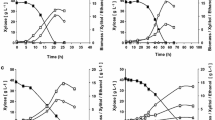Abstract
The kinetics and enzymology ofd-xylose utilization are studied in micro-, semi-, and aerobic batch cultures during growth ofCandida guilliermondii andCandida parapsilosis in the presence of several initial xylose concentrations. The abilities of xylitol accumulation by these two yeast strains are high and similar, although observed under various growth conditions. WithCandida parapsilosis, optimal xylitol production yield (0.74 g/g) was obtained in microaerobiosis with 100 g/L of xylose, whereas optimal conditions to produce xylitol byCandida guilliermondii (0.69 g/g) arose from aerobiosis with 300 g/L of sugar. The different behavior of these yeasts is most probably explained by differences in the nature of the initial step of xylose metabolism: a NADPH-linked xylose reductase activity is measured with a weaker NADH-linked activity. These activities seem to be dependent on the degree of aerobiosis and on the initial xylose concentration and correlate with xylitol accumulation.
Similar content being viewed by others
Literature Cited
Baillargeon MW, Jansen NB, Gong CS, Tsao GT (1983) Effect of oxygen uptake rate on ethanol production by a xylosefermenting yeast mutant,Candida sp XF 217. Biotechnol Lett 5:339–344
Barbosa MFS, De Medeiros MB, De Mancilha IM, Schneider H, Lee H (1988) Screening of yeasts for production of xylitol fromd-xylose and some factors which affect xylitol yield inCandida guilliermondii. J Ind Microbiol 3:241–251
Bruinenberg PM, De Bot PHM, Van Dijken JP, Scheffers WA (1984) NADH-linked aldose reductase: the key to anaerobic alcoholic fermentation of xylose by yeasts. Appl Microbiol Biotechnol 19:256–260
Delgenes JP, Moletta R, Navarro JM (1988) Fermentation ofd-xylose,d-glucose andl-arabinose mixture byPichia stipitis Y 7124: sugar tolerance. Appl Microbiol Biotechnol 29:155–161
Ditzelmuller G, Kubicek CP, Wöhrer W, Röhr M (1984) Xylitol dehydrogenase fromPachysolen tannophilus. FEMS Microbiol Lett 25:195–198
Du Preez JC, Bosch M, Prior BA (1986) Xylose fermentation byCandida shehatae andPichia stipitis: effects of pH, temperature and substrate concentration. Enzyme MicrobTechnol 8:360–364
Du Preez JC, Prior BA, Monteiro AMT (1984) The effect of aeration on xylose fermentation byCandida shehatae andPachysolen tannophilus. Appl Microbiol Biotechnol 19:261–266
Du Preez JC, Van Driessel B, Prior BA (1989) Effect of aerobiosis on fermentation and key enzyme levels during growth ofPichia stipitis, Candida shehatae andCandida tenuis ond-xylose. Arch Microbiol 152:143–147
Emodi A (1978) Xylitol. Its properties and food applications. Food Technol 1:28–32
Gong CS, Claypool TA, McCracken LD, Maun CM, Ueng PP, Tsao GT (1983) Conversion of pentoses by yeasts. Biotechnol Bioeng 25:85–102
Laplace JM, Delgenes JP, Moletta R, Navarro JM (1991) Alcoholic fermentation of glucose and xylose byPichia stipitis, Saccharomyces cerevisiae andZymomonas mobilis: oxygen requirement as a key factor. Appl Microbiol Biotechnol 36:158–162
Lewis DH, Smith DC (1967) Sugar alcohols (polyols) in fungi and green plants. Distribution, physiology and metabolism. New Phytol 66:143–184
Ligthelm ME, Prior BA, Du Preez JC (1988) The oxygen requirements of yeasts for the fermentation ofd-xylose andd-glucose to ethanol. Appl Microbiol Biotechnol 28:63–68
Lowry OH, Rosebrough NJ, Farr AL, Randall RJ (1951) Protein measurements with the Folin phenol reagent. J Biol Chem 193:265–275
McCracken LD, Gong CS (1983)d-xylose metabolism by mutant strains ofCandida sp. Adv Biochem Eng/Biotechnol 27:33–55
Meyrial V, Delgenes JP, Moletta R, Navarro JM (1991) Xylitol production fromd-xylose byCandida guilliermondii. Biotechnol Lett 13:281–286
Prior BA, Kilian SG, Du Preez JC (1989) Fermentation ofd-xylose by the yeasts.Candida shehatae andPichia stipitis. Process Biochem 24:21–32
Roseiro JC, Peito MA, Girio FM, Amaral-Collaço MT (1991) The effects of the oxygen transfer coefficient and substrate concentration on the xylose fermentation byDebaryomyces hansenii. Arch Microbiol 156:484–480
Schneider H, Mahmourides G, Labelle JL, Lee H, Maki N, McNeill J (1985) Correlation between limitation of growth ofPachysolen tannophilus ond-xylose with the formation of ethanol and other products. Biotechnol Lett 7:361–364
Verduyn C, Frank J, Van Dijken JP, Scheffers WA (1985) Multiple forms of xylose reductase inPachysolen tannophilus CBS 4044. FEMS Microbiol Lett 30:313–317
Washüttl J, Riederer P, Bancher E (1973) A qualitative and quantitative study of sugar-alcohols in several foods. J Food Sci 38:1262–1263
Watson NE, Prior BA, Du Preez JC, Lategan PM (1984) Oxygen requirements ford-xylose fermentation to ethanol and polyols byPachysolen tannophilus. Enzyme Microb Technol 6:447–450
Author information
Authors and Affiliations
Rights and permissions
About this article
Cite this article
Nolleau, V., Preziosi-Belloy, L., Delgenes, J.P. et al. Xylitol production from xylose by two yeast strains: Sugar tolerance. Current Microbiology 27, 191–197 (1993). https://doi.org/10.1007/BF01692875
Issue Date:
DOI: https://doi.org/10.1007/BF01692875



